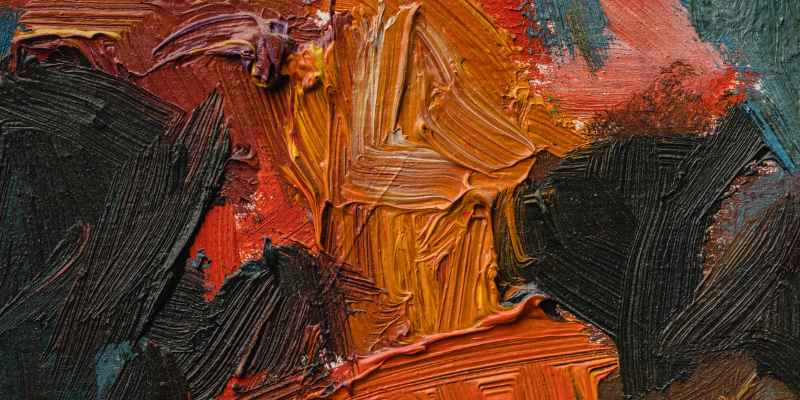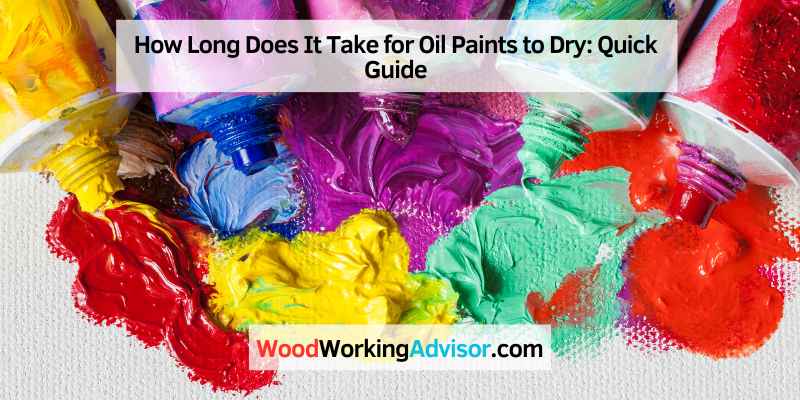Oil paints typically dry in stages, with the surface drying in a few hours to a couple of days, drying to the touch in several days to a week, and fully drying in a couple of months to a year. The exact drying time depends on various factors such as the thickness of the paint layers, the specific colors used, and the environmental conditions where the painting is drying.
Understanding these factors is crucial for artists to plan their painting process effectively and ensure the longevity of their artwork. Properly drying oil paints is essential to prevent smudging or damage to the finished piece and to achieve the desired results.
Factors Influencing Oil Paint Drying Times
The drying time of oil paints varies based on several factors such as the thickness of paint, humidity, and temperature. The surface dries in a few hours to a couple of days, while it takes several days to a week to dry to the touch.
However, it can take a couple of months to a year for the paint to fully dry.
Temperature And Humidity Effects
The drying time of oil paints is significantly influenced by the surrounding temperature and humidity. Higher temperatures and lower humidity levels facilitate faster drying, while cooler temperatures and higher humidity can prolong the drying process.
Oil Paint Thickness And Layers
The thickness of the oil paint layers also impacts the drying time. Thicker layers take longer to dry, as the outer layer dries first and restricts the evaporation of solvents from the underlying layers. Additionally, applying subsequent layers of paint before the previous layer has dried can extend the overall drying time.
Understanding these factors can help artists manage oil paint drying times effectively, ensuring optimal results for their artistic endeavors.
Stages Of Oil Paint Drying
Oil paint doesn’t dry like other types of paint. Instead, it undergoes various stages of drying, each with its own characteristics and timeline. Understanding these stages can help artists work with oil paints more effectively.
Surface Drying Phase
During the surface drying phase, which typically lasts a few hours to a couple of days, the top layer of the oil paint begins to oxidize as it’s exposed to the air. At this stage, the paint starts to lose its glossiness and becomes touch-dry on the surface.
Touch-dry Phase
The touch-dry phase, which occurs over several days to a week, is when the oil paint forms a skin on the surface. While it may feel dry to the touch, the underlying layers of paint are still in the process of drying. It’s important to handle the artwork with care during this phase to avoid smudging or damaging the paint.
Curing Phase
The final stage of oil paint drying is the curing phase, which can take anywhere from a couple of months to a year. During this time, the paint continues to harden as it reacts with oxygen. The colors also undergo subtle shifts as the paint fully cures, resulting in the final appearance of the artwork.
Average Drying Times For Oil Paints
Oil paints are known for their slow drying time, which allows artists to work with the paint for an extended period. However, the drying time can vary based on factors such as the thickness of the paint and the techniques used.
Thin Coats And Quick-drying Techniques
When applying thin coats of oil paint, the drying time is relatively shorter compared to thick coats. Additionally, artists can employ quick-drying techniques to expedite the drying process. These techniques include using a fast-drying medium or applying heat to the painting using a hairdryer or heat gun.
Thick Coats And Slow-drying Factors
Conversely, thick coats of oil paint can significantly prolong the drying time. Factors such as high humidity and low temperature can also contribute to slower drying times. Additionally, certain colors and pigments have inherently slower drying rates, impacting the overall drying time of the painting.
Accelerating The Drying Process
Using Drying Mediums
Drying mediums like alkyd-based mediums can speed up the drying process.
Appropriate Ventilation And Heat
Ensure proper ventilation and a slightly warm room to help oil paints dry faster.

Layering Technique: Fat Over Lean
In oil painting, the layering technique ‘fat over lean’ is crucial for proper drying. Initial layers with less oil dry faster, while subsequent layers with more oil take longer to dry, typically ranging from days to weeks for touch-dry and months to a year for full drying.
Understanding ‘fat Over Lean’
When it comes to oil painting, the layering technique of ‘Fat Over Lean’ is crucial to understand. This technique involves applying subsequent layers of paint with increasing amounts of oil content. The base layers, or lean layers, contain less oil and dry faster, while the top layers, or fat layers, contain more oil and dry slower. This technique is important because it prevents cracking and ensures the painting remains stable over time.
Applying Subsequent Layers
When applying subsequent layers of paint, it is important to follow the ‘Fat Over Lean’ technique. This means each layer should contain more oil than the previous layer. Failure to follow this technique can result in cracking and instability in the painting.
To ensure proper drying, it is also important to allow each layer to dry completely before applying the next layer. This can take anywhere from a few hours to a few days depending on the thickness of the layer and the amount of oil content.
To speed up the drying process, you can use a drying medium or mix the paint with a fast-drying solvent. However, it is important to use these with caution as they can affect the color and texture of the paint.
In conclusion, understanding the ‘Fat Over Lean’ layering technique is crucial for a successful oil painting. By following this technique and allowing each layer to dry completely before applying the next layer, you can ensure a stable and long-lasting painting.
Common Mistakes To Avoid
When it comes to oil paints, a common mistake to avoid is not allowing enough time for the paint to dry properly. It’s important to remember that oil paints can take several days to a week to dry to the touch, and up to a couple of months to fully dry.
Additionally, failing to prepare the painting surface properly or not allowing the paint to dry between coats can also lead to issues with drying.
When it comes to oil painting, understanding the drying time is crucial for achieving the desired results. However, many artists unknowingly make common mistakes that can prolong the drying process or even ruin their artwork. To help you avoid these pitfalls, here are some of the most common mistakes to steer clear of:
Insufficient Surface Preparation
One of the key mistakes artists make is failing to properly prepare the painting surface before applying the oil paint. This can lead to issues with adhesion and drying time. To ensure proper surface preparation, follow these steps:
- Clean the surface: Remove any dust, dirt, or debris from the canvas or painting surface using a clean, lint-free cloth.
- Apply a primer: Apply a suitable primer or gesso to create a smooth and absorbent surface for the oil paint to adhere to.
- Allow the primer to dry: Give the primer ample time to dry according to the manufacturer’s instructions.
By taking the time to properly prepare the painting surface, you can ensure better adhesion and a more efficient drying process.
Impatience Between Coats
Another common mistake artists make is not allowing enough time for each layer of oil paint to dry before applying the next coat. This impatience can result in the layers mixing together and not drying properly, leading to a longer overall drying time. To avoid this mistake, follow these guidelines:
- Allow each layer to dry to the touch: Before applying another layer of oil paint, make sure the previous layer is dry to the touch. This usually takes several days to a week, depending on the thickness of the paint and environmental factors.
- Consider the “fat over lean” rule: When working with multiple layers, it is important to follow the “fat over lean” rule. This means that each subsequent layer should contain more oil than the previous layer, allowing for proper drying and stability.
By being patient and allowing sufficient drying time between coats, you can prevent issues with mixing and ensure a more efficient overall drying process.
Testing Paint Dryness
Determining the dryness of oil paints depends on various factors, such as the quality of the paint, environmental conditions, and the application process. Typically, oil paints dry in stages, with the surface drying in a few hours to a couple of days, becoming touch-dry in several days to a week, and fully drying in a couple of months to a year.
Tackiness Test
One way to test the dryness of oil paints is by performing the tackiness test. This test involves lightly touching the surface of the paint with a clean finger or a piece of cloth. If the paint feels sticky or leaves residue on the finger, it is not fully dry. On the other hand, if the paint feels dry and does not leave any marks, it has reached the desired level of dryness.
The Dent Test
Another method to determine if oil paints are dry is by conducting the dent test. This test involves gently pressing a fingernail or a small object into the paint surface. If the paint is still wet, it will leave a visible dent that does not bounce back. However, if the paint is dry, it will not leave a dent and the surface will remain intact.
It is important to note that the drying time of oil paints can vary depending on various factors such as the thickness of the paint layer, the type of oil used, the humidity and temperature of the environment, and the presence of drying agents or mediums.
Generally, oil paints can take anywhere from a few hours to a couple of days to dry on the surface. However, they may take several days to a week to dry to the touch, and it can take several months to a year for the paint to fully dry and cure. It is crucial to allow sufficient drying time between layers to ensure the stability and longevity of the painting.
Proper preparation of the painting surface and following the recommended drying techniques can also contribute to the drying time of oil paints. It is essential to ensure that the surface is clean, free from dust and debris, and properly primed before applying the paint. Additionally, allowing the paint to dry between coats helps prevent issues such as cracking or lifting of the paint layers.
By understanding and testing the dryness of oil paints, artists can ensure that their artwork is properly dried and ready for varnishing or framing. This knowledge also helps in avoiding potential issues such as smudging or damage to the painting during handling or transportation.
In conclusion, testing the dryness of oil paints is crucial for artists to achieve the desired results in their artwork. The tackiness test and the dent test are effective methods to determine the dryness of the paint. It is important to consider various factors that can affect the drying time and follow proper techniques to ensure the stability and quality of the finished painting.
Additional Tips For Managing Drying Times

When it comes to oil painting, managing drying times is crucial to ensure the success of your artwork. By understanding the factors that affect drying times and implementing the right techniques, you can have better control over the process. Here are some additional tips to help you manage drying times effectively:
Choosing The Right Environment
The environment in which you paint plays a significant role in the drying time of oil paints. Factors such as humidity and temperature can greatly influence how quickly or slowly the paint dries. Here are a few things to consider:
- Optimal humidity: Aim for a humidity level of around 40-50% for ideal drying conditions. High humidity can prolong the drying process, while low humidity can cause the paint to dry too quickly, leading to cracking.
- Temperature control: Maintain a consistent temperature between 65-75°F (18-24°C) in your painting area. Extreme temperatures can affect the drying time and overall quality of the paint.
- Avoid damp environments: Ensure that your painting space is free from excessive moisture, as it can interfere with the drying process and cause mold or mildew to develop on the artwork.
Oil Paints On Different Surfaces
The type of surface you paint on can also impact the drying time of oil paints. Here are a few considerations when working with different surfaces:
| Surface Type | Drying Time |
|---|---|
| Canvas | Oil paints on canvas tend to dry slower due to the absorbent nature of the material. Be prepared for longer drying times, especially for thick layers of paint. |
| Wood | When painting on wood, the drying time can vary depending on the type of wood and its preparation. It is advisable to prime the surface with a suitable primer to enhance adhesion and facilitate drying. |
| Metal | Metals can conduct heat, which can accelerate the drying time of oil paints. However, it’s essential to ensure proper adhesion by using a suitable primer designed for metal surfaces. |
By understanding the drying characteristics of different surfaces, you can adjust your painting techniques and expectations accordingly.
Overall, managing drying times in oil painting requires careful consideration of the painting environment and surface type. By choosing the right environment and adapting your techniques accordingly, you can ensure optimal drying times and preserve the quality of your artwork.
Faqs On Oil Paint Drying
Concerned about how long oil paints take to dry? The drying time for oil paints varies depending on factors such as humidity, thickness of paint layers, and the type of oil used. Typically, oil paints can take several days to a week to dry to the touch, and a few months to a year to fully dry.
Dry Time For Oil Paint On Paper
When it comes to drying oil paint on paper, the process can vary depending on several factors. Generally, oil paint on paper will dry at a slower rate compared to other surfaces, such as canvas or wood. This is because paper is more absorbent and allows the paint to penetrate deeper into its fibers.
The drying time for oil paint on paper can range from a few days to several weeks. Factors such as the thickness of the paint layers, the type of oil used, and the environmental conditions can all affect the drying time. Thicker paint layers will take longer to dry, while thinner layers will dry more quickly.
To speed up the drying process, you can use techniques such as adding a drying medium to your paint or placing your artwork in a well-ventilated area with low humidity. However, it’s important to note that rushing the drying process can affect the quality and longevity of your artwork.
Drying Oil Paint On Non-traditional Surfaces
Drying oil paint on non-traditional surfaces, such as glass or metal, can present some challenges. These surfaces are often less porous, making it difficult for the paint to adhere and dry properly.
To ensure proper drying, it’s important to prepare the surface before applying the oil paint. This may involve roughening the surface slightly to provide better adhesion or using a suitable primer or base coat.
The drying time for oil paint on non-traditional surfaces can vary depending on the type of surface and the thickness of the paint layers. In general, it may take longer for the paint to dry compared to traditional surfaces like canvas or wood.
To speed up the drying process, you can use techniques such as adding a drying medium or heat-setting the paint. However, it’s important to follow the manufacturer’s instructions and take precautions to avoid damaging the surface.
In conclusion, the drying time for oil paints can vary depending on the surface and other factors. It’s important to be patient and allow the paint to dry fully before applying additional layers or varnish. By understanding the drying process and taking proper precautions, you can create beautiful oil paintings that will stand the test of time.

Frequently Asked Questions
How Long Does Oil Paint Take To Fully Dry?
Oil paint typically dries in stages: surface drying in a few hours to days, touch-dry in several days to a week, and fully dry in a few months to a year.
How Do You Dry Oil Paint Easily?
To dry oil paint easily, ensure the quality of the paint and prepare the surface properly. Let each coat dry completely before applying the next one. Maintain a suitable painting environment with proper humidity and temperature levels. Use a drying medium or a fan to speed up the process.
Avoid thick layers as they take longer to dry. Full drying may take from a few days to a year.
Why Is My Oil-based Paint Still Tacky After 24 Hours?
Oil-based paint may stay tacky due to poor paint quality, unsuitable painting conditions, or improper surface preparation.
Do You Have To Wait For Oil Paint To Dry Between Layers?
Wait for oil paint to dry between layers to ensure the previous layer is fully dry before adding more.
Conclusion
The drying time of oil paints can vary depending on various factors such as the thickness of the paint, humidity, temperature, and the type of oil used. While the surface of the paint may dry in a few hours or a couple of days, it may take several weeks or even months for the paint to fully dry and cure.
It is important to follow proper techniques and allow sufficient time for each layer to dry before applying the next one. By understanding the drying times of oil paints, artists can create beautiful and long-lasting paintings.


